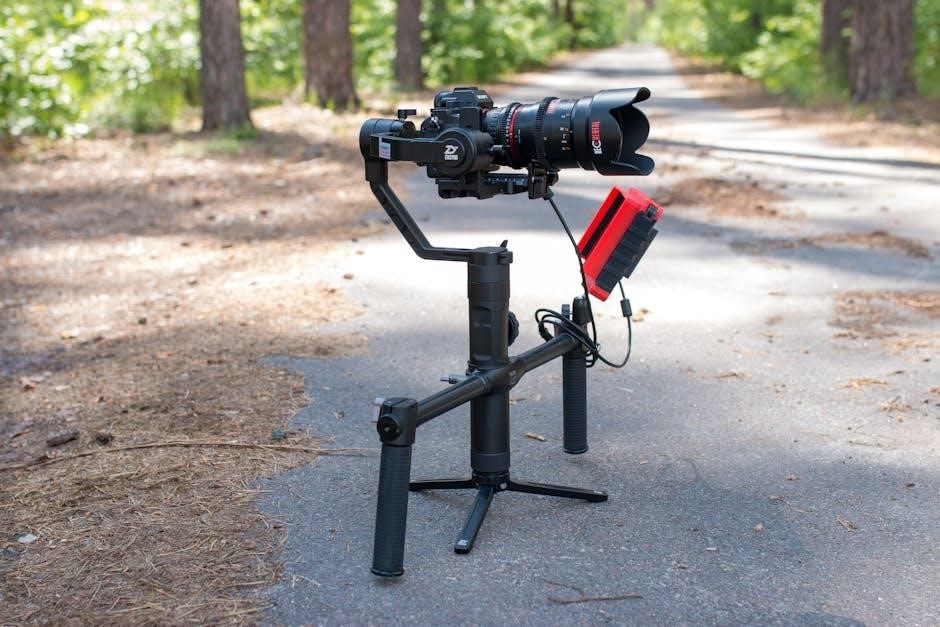The Canon PIXMA TS7720 is a wireless all-in-one printer offering high-quality printing‚ scanning‚ and copying. Proper setup ensures optimal performance and seamless connectivity for home or office use.
Overview of the Printer and Its Features
The Canon PIXMA TS7720 is a wireless all-in-one inkjet printer designed for versatile home and office use. It features high-quality printing‚ scanning‚ and copying capabilities with a compact design. The printer supports wireless and wired connectivity‚ allowing seamless integration with computers‚ smartphones‚ and tablets. With a 4.3-inch LCD touchscreen‚ users can easily navigate settings and print directly from the device. It delivers crisp text and vibrant photos with a maximum print resolution of 9600 x 2400 dpi. The TS7720 also supports dual paper feeding‚ automatic two-sided printing‚ and direct photo printing from SD cards. Its compatibility with the Canon Print App ensures effortless mobile printing and scanning.
Importance of Proper Setup for Optimal Performance
Importance of Proper Setup for Optimal Performance
Proper setup of the Canon PIXMA TS7720 is essential to unlock its full potential and ensure smooth operation. A well-executed setup guarantees high-quality prints‚ reliable wireless connectivity‚ and compatibility with various devices. Incorrect installation can lead to connectivity issues‚ poor print quality‚ or even device incompatibility. By following the setup instructions carefully‚ users can avoid common problems and enjoy seamless functionality across printing‚ scanning‚ and copying. A proper setup also ensures that the printer’s advanced features‚ such as wireless printing and mobile device integration‚ work flawlessly. This makes the Canon PIXMA TS7720 a versatile and efficient addition to any home or office environment.
System Requirements for Canon PIXMA TS7720
The Canon PIXMA TS7720 requires compatible operating systems like Windows 10 or later‚ macOS 10.14 or later‚ iOS‚ or Android for smooth operation. Ensure your device meets minimum hardware specifications and has a stable wireless network connection for seamless functionality.
Compatible Operating Systems (Windows‚ macOS‚ iOS‚ Android)
The Canon PIXMA TS7720 is compatible with a wide range of operating systems‚ ensuring versatility for different devices. It supports Windows 10‚ 8.1‚ 8‚ and 7‚ as well as macOS High Sierra (10.13) and later versions. Additionally‚ it works seamlessly with iOS and Android devices‚ enabling wireless printing from smartphones and tablets. This broad compatibility allows users to connect and print from various platforms‚ making it ideal for both home and office environments. The printer also supports direct wireless connections‚ such as Wi-Fi Direct‚ for effortless printing without needing a router. For mobile devices‚ the Canon PRINT app provides a convenient setup and printing experience. This versatility ensures smooth integration across multiple operating systems.
Minimum Hardware Specifications for Smooth Operation

For the Canon PIXMA TS7720 to operate smoothly‚ ensure your device meets the minimum hardware requirements. A computer or mobile device with a 1 GHz or faster processor is recommended. At least 2 GB of RAM is needed for efficient performance‚ though 4 GB or more is ideal for multitasking. Ensure your system has sufficient storage to install the printer drivers and software. A USB port or wireless connectivity option is required for direct connection. For wireless setups‚ a compatible router and stable internet connection are essential. Ensure your device’s operating system is up-to-date to support all printer features and functionalities effectively.
Unboxing and Physical Setup of the Printer
Unbox the Canon PIXMA TS7720 carefully‚ ensuring all accessories like power cords‚ ink cartridges‚ and manuals are included. Place it on a flat‚ stable surface for proper installation and connectivity.
Unpacking the Printer and Accessories
When you unbox the Canon PIXMA TS7720‚ carefully remove the printer and all included accessories from the packaging. The box typically contains the printer unit‚ ink cartridges‚ a power cord‚ USB cable‚ and a setup guide. Ensure all protective materials are removed from the printer’s exterior and interior. Handle the print head and ink cartridges with care to avoid damage. Check for any additional items like sample paper or CDs for drivers. Organize the accessories to ensure nothing is misplaced. Before proceeding‚ verify that all components are included to avoid delays during setup. Properly dispose of the packaging materials to prevent clutter and potential hazards.
Physical Placement and Connectivity Options
Proper physical placement and connectivity are crucial for the Canon PIXMA TS7720 to function optimally. Place the printer on a flat‚ stable surface away from direct sunlight and moisture. Ensure it is within range of your wireless router for a strong connection. Connectivity options include wireless‚ Ethernet‚ or USB. For wireless setup‚ position the printer near your router to avoid signal loss. Use the LCD screen to navigate connectivity settings. Ensure the printer is at least 8 inches away from walls or obstructions for proper ventilation. A well-planned setup ensures reliable performance and minimizes connectivity issues during operation.

Printer Setup Process

Printer Setup Process
The Canon PIXMA TS7720 setup begins with powering on the printer‚ navigating the initial setup wizard‚ and installing the print head and ink cartridges.
Powering On the Printer for the First Time

To power on the Canon PIXMA TS7720 for the first time‚ locate the power button on the top-right side of the printer. Plug the printer into a power outlet using the provided cable. Press and hold the power button until the LCD screen lights up and the printer initializes. This process may take a few moments. Once powered on‚ the printer will automatically enter setup mode. Follow the on-screen instructions to select your language and country/region. Ensure all accessories‚ such as ink cartridges and the print head‚ are properly installed before proceeding with further setup steps. This initial power-on step is crucial for initializing the printer’s systems.
Navigating the Initial Setup Wizard
The initial setup wizard guides you through configuring the Canon PIXMA TS7720. Upon powering on‚ the printer displays language and region selection. Next‚ choose your connection method: wireless‚ wired‚ or direct wireless. For wireless setups‚ select your network from the list‚ enter the password‚ and confirm. The wizard will also prompt you to install printheads and ink cartridges. Follow on-screen instructions to align the printhead and perform a test print. Ensure your router is nearby and restart it if connectivity issues arise. Registering your printer with a Canon account may be required for full functionality. This process ensures a smooth and efficient setup experience.
Installing the Print Head and Ink Cartridges
To install the print head and ink cartridges on your Canon PIXMA TS7720‚ first‚ ensure the printer is powered on. Open the top cover and wait for the print head to move to the installation position. Carefully unpack the print head and ink cartridges‚ ensuring not to touch the electrical contacts. Insert the print head into its slot until it clicks. Next‚ install the ink cartridges one by one‚ aligning the color labels with the corresponding slots. Gently push each cartridge until it clicks into place. Close the printer cover and allow the printer to automatically recognize and prepare the new cartridges for use. Always use original Canon cartridges for optimal performance.
Connecting the Printer to a Network
The Canon PIXMA TS7720 offers versatile network connectivity options‚ including wireless‚ wired Ethernet‚ and Wi-Fi Direct‚ ensuring easy setup and reliable connection to your home or office network.
Wireless Connection Setup via the Printer’s LCD
To set up the Canon PIXMA TS7720 wirelessly using the LCD‚ start by turning on the printer. Navigate to the settings menu using the buttons on the side or below the screen. Select ‘Wireless Setup’ or ‘Network Configuration.’ The printer will search for available networks. Choose your Wi-Fi network from the list. Enter your password using the on-screen keyboard with the arrow keys and ‘OK’ button. Wait for the printer to connect. A confirmation message will appear once connected. If it fails‚ double-check the password and network name. After connection‚ install drivers from Canon’s website for wireless printing from devices on the same network.
Wired Ethernet Connection Configuration
To set up a wired Ethernet connection for the Canon PIXMA TS7720‚ ensure you have an Ethernet cable and an available LAN port on your router. Connect one end of the cable to the printer’s Ethernet port‚ located on the rear‚ and the other end to your router. Power on the printer and navigate to the settings menu via the LCD screen. Select Network Settings‚ then choose Wired LAN to enable the wired connection. Follow the on-screen instructions to complete the setup. Once connected‚ your printer will be accessible from any device on the same network‚ ensuring stable and reliable communication for printing‚ scanning‚ and copying tasks.
Direct Wireless Connection (Wi-Fi Direct)
Direct Wireless Connection‚ or Wi-Fi Direct‚ allows your Canon PIXMA TS7720 to connect directly to compatible devices without a router. Enable Wi-Fi Direct on the printer via the LCD menu under wireless settings. On your device‚ select the printer’s SSID from the Wi-Fi list and enter the password displayed on the printer’s screen. This method is ideal for quick printing from smartphones or tablets. Ensure both devices support Wi-Fi Direct for a seamless connection. Once connected‚ you can print documents or photos directly from your device using Canon’s PRINT app or standard printing options.

Downloading and Installing Printer Drivers
Visit the official Canon website to find and download the latest drivers for the PIXMA TS7720. Ensure compatibility with your operating system for smooth functionality and optimal performance.
Checking the Canon Website for Latest Drivers
To ensure your Canon PIXMA TS7720 operates smoothly‚ visit the official Canon support website for the latest printer drivers. Navigate to the Support section‚ enter your printer model‚ and select your operating system. Download the most recent driver version to maintain compatibility and performance. Regularly updating drivers enhances functionality and resolves potential issues. Always verify the source to avoid unauthorized downloads. This step is essential for ensuring optimal printing‚ scanning‚ and connectivity features.
Downloading and Installing Drivers for Windows

To ensure smooth operation of the Canon PIXMA TS7720 on Windows‚ download the latest drivers from the official Canon website. Visit the Canon support page‚ select your printer model‚ and choose the correct Windows OS version. Click “Download” to get the driver installer. Run the downloaded file and follow the on-screen instructions to install the drivers. During installation‚ you may be prompted to connect the printer to your computer via USB or wirelessly. Once installed‚ restart your printer and computer to apply the changes. This ensures optimal performance and compatibility with your Windows system.
Downloading and Installing Drivers for macOS and Mobile Devices
For macOS and mobile devices‚ visit the Canon website to download the latest drivers. Select your printer model‚ choose macOS or mobile options‚ and follow the download instructions. Ensure your device is connected to the same network as the printer. For mobile devices‚ download the Canon PRINT app from the App Store or Google Play Store. Open the app‚ select your printer‚ and follow the in-app setup guide. Ensure Bluetooth and Wi-Fi are enabled for a smooth connection. After installation‚ restart your device and printer to confirm functionality. This ensures compatibility and optimal performance across all devices.

Setting Up the Printer on Different Devices
Setting up the Canon PIXMA TS7720 on various devices involves installing the appropriate drivers and connecting the printer to your network. For Windows‚ download the latest drivers from the Canon website and follow the installation wizard. On macOS‚ use the printer settings to add the device. For iOS and Android‚ use the Canon PRINT Inkjet/SELPHY app to establish a wireless connection. Ensure all devices are on the same network for seamless printing.
Setting Up on Windows Computers
To set up the Canon PIXMA TS7720 on a Windows computer‚ start by ensuring both devices are connected to the same Wi-Fi network. Download the latest printer driver from the Canon website and run the installer. Follow the on-screen instructions to install the driver and complete the setup wizard. Once installed‚ navigate to Settings > Devices > Printers & Scanners to add the printer. Select Add a printer or scanner and choose the Canon PIXMA TS7720 from the list. If it doesn’t appear‚ ensure the printer is turned on and properly connected to the network. After successful installation‚ test the setup by printing a document to confirm functionality.
Setting Up on macOS Computers
To set up the Canon PIXMA TS7720 on your macOS computer‚ start by ensuring both devices are connected to the same Wi-Fi network. Power on the printer and navigate to its wireless setup menu to select your network and enter the password. Once connected‚ visit the Canon website to download the latest macOS drivers for the TS7720. Run the installer and follow the prompts to install the software. After installation‚ open System Preferences and go to Printers & Scanners. Click the ‘+’ button to add a new printer‚ and select the TS7720 from the list. If it doesn’t appear automatically‚ you may need to enter the printer’s IP address manually. Finally‚ print a test page to confirm successful setup. For any issues‚ restart both devices‚ check network settings‚ or contact Canon support for assistance.
Setting Up on iOS and Android Devices
To set up the Canon PIXMA TS7720 on iOS or Android devices‚ download the Canon PRINT app from the App Store or Google Play Store. Open the app‚ select your printer model‚ and follow the on-screen instructions to connect it to your Wi-Fi network. Ensure your device and printer are on the same network for seamless connectivity. The app will guide you through pairing and configuring settings. Once connected‚ you can print photos‚ documents‚ or scan directly from your smartphone. For direct wireless printing without a router‚ use the printer’s Wi-Fi Direct feature. This setup allows easy mobile printing and scanning‚ enhancing productivity and convenience for users on the go.
Troubleshooting Common Setup Issues
Common setup issues include wireless connectivity problems‚ print quality inconsistencies‚ and paper jams. Ensure proper network connection‚ check ink levels‚ and clean paper rollers for smooth operation.
- Restart the printer and router to resolve wireless connectivity issues.
- Align the print head and check cartridge installation for print quality problems.
- Clear paper jams gently to avoid damaging internal mechanisms.

Resolving Wireless Connectivity Problems
Wireless connectivity issues with the Canon PIXMA TS7720 can often be resolved by restarting the printer‚ router‚ and device. Ensure the printer is connected to the correct Wi-Fi network and within range. If the connection fails‚ reset the printer’s network settings via the LCD menu and reconfigure. Check for firmware updates‚ as outdated software can cause connectivity problems. If issues persist‚ disable the firewall temporarily or consult Canon’s support resources for advanced troubleshooting steps.
Fixing Print Quality and Paper Jam Issues

To resolve print quality issues on the Canon PIXMA TS7720‚ ensure the print head is clean and properly aligned. Use genuine Canon ink cartridges for consistent results. For streaked or blurred prints‚ run the printer’s cleaning cycle via the LCD menu. If paper jams occur‚ carefully remove the jammed paper from the rear or front tray‚ then restart the printer. Always use the recommended paper type and size to avoid jams. Regularly cleaning the printer’s interior and updating drivers can also improve performance. Addressing these issues promptly ensures smooth operation and maintains the printer’s efficiency for high-quality output.

Be First to Comment